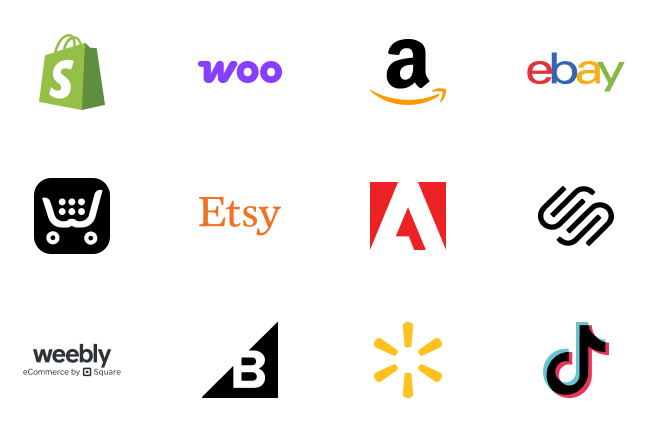One of the biggest decisions you’ll make as an eCommerce merchant is where you sell your products. Shopify vs. Amazon are very different, and it's best to choose the platform that lets you sell the way you want.
Both eCommerce platforms are great for both eCommerce newbies and veterans. Amazon and Shopify can even be used side by side.
This guide explains the key differences and similarities between two eCommerce heavyweights: Shopify vs. Amazon. Easyship integrates with both platforms instantly. We also save you up to 91% off shipping for both Amazon and Shopify.
You can try Easyship for free for 50 shipments every month.
What’s the Difference Between Shopify vs. Amazon?
Shopify vs. Amazon is like comparing apples to oranges. Both platforms let you sell products online, but your experience as a seller will be very different on each.
Amazon is an online marketplace that lists the products of thousands of third-party sellers – one of which could be you.
Millions of people visit Amazon daily, making selling on Amazon a quick way to reach millions of potential customers. In exchange for instant reach, Amazon charges fees to sellers, including:
- Listing fees
- Transaction fees
- Payment processing fees
- Fulfillment fees (if you use Fulfillment by Amazon)
These fees reduce your margins, but many are happy to give Amazon a cut in exchange for access to a huge supply of global shoppers. To sell on Amazon, you just need to create an Amazon seller’s account, list your products and play by the rules and restrictions of the platform.
By contrast, Shopify is an eCommerce platform that lets you build and customize your own online store.
Shopify gives you the tools to build a unique brand storefront for your products. The platform offers help with marketing, shipping, and more to help you succeed as an eCommerce solopreneur.
Unlike Amazon, Shopify is for DIY-ers. It’s your responsibility to drive traffic to your site, gain buyers’ trust, and coordinate fulfillment. This is on top of everyday eCommerce activities like listing products, optimizing your store, and more.
Selling on Shopify vs. Amazon: The Difference
Visibility is the main difference between Shopify vs. Amazon. Amazon is a massive platform that puts you within reach of book buyers. Thing is, you’re just one seller among many and your store looks like everyone else’s. Only your products and your off-site marketing can differentiate you.
With Shopify, you’re the captain of your eCommerce shop. You’re free to design your storefront and conduct business as you like. But without any site traffic to start, you’ll work harder for your sales – especially in the beginning.
You can use Shopify and Amazon together. It’s common for Shopify merchants to list their most popular products on Amazon and other marketplaces. Doing so helps them generate sales and trust for their brand website.
Using these complementary eCommerce business models together is what’s known as omnichannel eCommerce. To learn more about omnichannel eCommerce, check out this blog.
The Pros and Cons of Selling on Amazon
Amazon is one of the world’s largest and most trusted eCommerce platforms. Nearly 9 in 10 shoppers say they trust products purchased on Amazon. Meanwhile, over 4,000 items get sold on Amazon every minute.
It’s simple to sell on Amazon. Simply create an Amazon Seller account, follow the product listing flow, optimize, and you’re in business. Optimizing item listings is vital because most Amazon sales traffic comes via search queries. If your listing isn’t search-friendly, you’re missing out.
Selling on Amazon is made even easier by a feature called Fulfillment by Amazon (FBA). For a fee, Amazon handles all shipping and fulfillment on your behalf. This takes the headache out of eCommerce shipping but also takes a bite out of your profits.
Pros:
- Access to millions of global buyers
- Fast and easy guided setup
- Instant credibility from an Amazon storefront
- Gain visibility with motivated buyers via Amazon search bar
- Simplified returns and refunds processing
- Sales analytics for optimized business performance
- Done-for-you fulfillment is available via FBA
- Built-in customer service
- Free trial
Overall, Amazon has created a seamless experience for its sellers. Here’s what you might be less excited about:
Cons:
- Paying 15% – 40% of each sale to Amazon
- Competing for sales with other sellers
- Zero customization or design for your storefront
- Competitive tactics in a saturated market
- Following Amazon’s rules
The takeaway: You may find that the fees, restrictions, and competition on Amazon aren’t worth your while. Certain product niches may be oversaturated, in which case, you’re better off selling on another marketplace or sticking with Shopify. But if you have a good eye for trending eCommerce products, selling on Amazon can be super lucrative.
The Pros and Cons of Selling on Shopify
Shopify is a leading eCommerce platform that helps you build a custom web store without any technical expertise. From 2019 to 2020, the number of people who bought from a Shopify store boomed by 52%.
Shopify is both easy to use and feature-rich, making it a powerful tool for eCommerce newcomers and veteran sellers alike. Shopify shows you how to build a store, list your products – everything you need to sell online.
Unlike Amazon, Shopify is your online store.
Pick from a variety of design templates then stylize your brand presence online. The challenge with Shopify is to craft a store experience that’s both authentic to you and sales-optimized. It's recommended that you follow best practices for eCommerce store design.
Pros:
- Affordable
- Easy to use
- Full control over your store
- Create a brand identity
- Mobile-friendly store
- Access to helpful tools and apps
- Free trial
Shopify is a flexible and user-friendly website builder for eCommerce. But it has its downsides, including:
Cons:
- You’re responsible for marketing your store and driving traffic
- Marketing takes time, money, and expertise
- Hard to generate trust with first-time buyers
- Pay monthly Shopify use fee, plus for extra apps in the store
- Transaction fees on all payments not processed by Shopify
- Restricted access to features like analytics on cheapest plans
Takeaway: The biggest challenge for new eCommerce merchants is marketing. With Shopify, it’s up to you to gain visibility, design an effective storefront, and optimize for sales. For the trouble, you have full control over your brand and greater profits per sale. If you’re an eCommerce brand in it for the long haul, you’ll eventually need a website – so why not make it Shopify?
Shipping on Shopify vs. Amazon
Shipping is an oft-overlooked part of eCommerce, but it’s crucial to your bottom line. Recent estimates put the cost of fulfillment for eCommerce brands between 25-35% of total costs.
Today’s eCommerce buyers expect a fast, reliable, and often free delivery experience. You can thank Amazon for that. Even if buyers are willing to pay for shipping, you’ll need to compare couriers to get the cheapest rates on shipments.
Complicating this is the fact that courier rates vary by several factors, including:
- Delivery destination
- Delivery lead time
- Item size
- Weight
- Added features like insurance and signature confirmation
Here’s how shipping on Amazon and Shopify differ.
Shipping with Amazon
Amazon Sellers get to choose if they want to coordinate shipping themselves or use Fulfillment by Amazon, or Amazon FBA.
Self-shipping on Amazon
- Compare couriers to find the cheapest rates (try a free rate calculator)
- Coordinate fulfillment yourself
- Use couriers that fit your budget and customer expectations
- Integrate orders with shipping software like Easyship to streamline fulfillment & save up to 91% off shipping
Amazon FBA
- Amazon coordinates fulfillment for you
- You pay up to 40% per sale to Amazon in various fees
- Faster shipping for greater customer satisfaction
The takeaway: Amazon FBA is a done-for-you fulfillment option for Amazon Sellers. It costs but simplifies your selling experience. It also delivers items to customers quickly for greater customer satisfaction.
Self-service shipping on Amazon is made easier with shipping platforms like Easyship. Our all-in-one platform integrates with your Amazon Seller’s account, letting you compare and use the cheapest rates for all shipments automatically.
Shipping with Shopify
Shopify merchants can choose to fulfill orders themselves or use Shopify Shipping, a free fulfillment tool native to Shopify.
Shopify Shipping
- Only available for orders shipped from US and Canada
- Get slightly discounted rates on shipping
- Show rates in the checkout from USPS, UPS, DHL Express, and Canada Post
- Coordinate fulfillment yourself
- Use couriers that fit your budget and customer expectations
- Integrates with shipping software like Easyship to really simplify and save on shipping
Self-service shipping on Shopify
- Compare couriers to find the cheapest rates (try a free rate calculator)
- Coordinate fulfillment yourself
- Absorb costs of shipping
- Use couriers that fit your budget and customer expectations
- Integrate Shopify instantly with shipping software like Easyship to streamline fulfillment & save up to 91% off shipping
The takeaway: Shopify sellers can use Shopify Shipping for free, so why not? You’re still fulfilling orders yourself, but you get a boost from some cart automation and shipping discounts.
For best results, integrate your Shopify store with Easyship’s all-in-one shipping platform to manage all shipping activity in one place and save up to 91% off all courier rates. When it comes to Amazon FBA vs. Shopify, Amazon FBA is way easier and more expensive by a wide margin.
Shopify vs. Amazon with Easyship
Amazon makes selling easy with a cookie-cutter store and instant access to millions of potential buyers. The question is: do people want what you’re selling in the saturated Amazon marketplace?
Shopify takes more legwork but once you’re up and running, you’re the boss of a unique and profitable web store. Full control brings total responsibility for the essential marketing practices that drive site traffic and sales. Are you ready for the DIY eCommerce experience?
Easyship saves you money and streamlines shipping no matter which eCommerce platform you use. We integrate instantly with both Shopify vs. Amazon. You can ship up to 50 shipments free per month with Easyship if you want to give us a try. You can create a free account here.















































.svg)
.svg)






.avif)
.avif)

.avif)
.avif)


.avif)


.avif)










.avif)
.avif)



.avif)
.avif)


.avif)
.avif)


.avif)











.svg)





.webp)